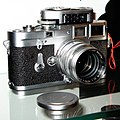Leica M3
 Single-stroke M3 with collapsible Summicron 50mm f/2.0 lens | |
| Overview | |
|---|---|
| Type | 35 mm rangefinder camera |
| Lens | |
| Lens mount | Leica M mount |
| Focusing | |
| Focus | manual |
| Exposure/metering | |
| Exposure | manual |
| Flash | |
| Flash | standard accessory shoe with separate bulb and electronic flash connectors |
| General | |
| Dimensions | 138 x 77 x 33.5mm, 580g |
The Leica M3 was a 35 mm rangefinder camera by Leica AG, introduced in 1954. It was a new starting point for Leitz, which until then had only produced screw-mount Leica cameras that were incremental improvements to its original Leica (Ur-Leica). Leica M cameras are still in production today. The M3 introduced several features to the Leica, among them the combination of viewfinder and rangefinder in one bright window, like on the Contax II, and a bayonet lens mount. It was the most successful model of the M series, with over 220 000 copies sold.
Mount
This new bayonet mount, which has not been changed in the following half century, is called the Leica M mount. Lenses are changed faster than with a screw mount, and framelines set automatically. Non-Leitz/Leica bayonet-mount lenses can also be used (although none were produced in any quantity while the M3 was sold), and a simple adapter also allows the use of screwmount lenses (whether from Leitz or other companies).
-
Two M3s fitted with 50mm and 90mm collapsible lenses
Viewfinder
The M3 has an exceptionally bright viewfinder when compared to a Leica IIIf, the previous Leica release (the subsequent member of the Leica III family, the IIIg, was released in 1957 with a much improved viewfinder). The M3 has a high magnification factor of 0.92×, which is very useful in critical focusing, and especially with long lenses (subsequent Leicas would use 0.85×, 0.72× or 0.54×).

It was the first Leica to combine rangefinder and viewfinder into one window. (Other cameras, such as the Contax II, already had this feature before the war; and other companies were making screwmount bodies with combined finders.) Framelines for 50, 90 and 135mm are shown, although none for any wider lenses. However, Leica solved this problem in two different ways:
- a separate viewfinder slid into the accessory shoe.
- the so-called "Leica glasses": auxiliary lenses are put in front of the viewfinder and rangefinder windows for the 35mm focal length. The drawback of these glasses is they reduce the famed brightness of the finder.
The 50 mm framelines are always visible. The viewfinder image is slightly larger. There are two ways to select the 90mm or 135mm framelines:
- putting a 90mm lens on the camera will automatically select the corresponding framelines
- toggling a small lever on the left of the lens. This way, one can see the tele-framelines when using a 50mm lens. It helps visualise the field of view for another focal length. (Earlier versions did not have a lever to view the 90mm frameline without attaching the lens.)
-
50 mm
-
90 mm
-
135 mm
Viewfinder cameras do not show the exact same image in the viewfinder and on the film, due to the distance of the viewfinder to the view axis of the lens. This parallax problem is compensated in the M3 by moving the framelines when the lens is focused. This parallax compensation is limited to one metre; closer distances require special "Leica glasses".
Film transport

Leica IIIf and its predecessors had used a knob to advance the film. For fear of tearing the film, early M3s had a double stroke advance lever, like the Neoca 2s would. Later models (from model no 915 251) had single-stroke levers, which quickened up operation of the camera. Another type of variation is in the film pressure plate used. Early models used a glass plate to keep the film flat; later models used a metal plate.
Loading of the film is done by removing the bottom plate, like on the Leica II and III series; part of the rear of the camera can be collapsed, allowing for easier access to the film. The film is rolled around a removable take-up spool before being inserted from the bottom.
Shutter

Previous screw mount Leicas used two separate shutter speed dials for slow and fast speeds (the fast speed dial on top of the camera rotated during firing). The M3 combined slower and faster speeds and the dial does not rotate during firing. Supposedly, this reduces vibrations in the camera. Early models used a non-geometrical series of shutter speeds. On later models this became the international standard of 1s to 1/1000s.
Variants and successors
Variants of the M3 were made for specific purposes. The Leica 24x27 was a camera with no rangefinder nor viewfinder, made for the postal service to photograph electricity meters.
The M3 was succeeded by the M2, a bit simpler and more reportage-oriented, with a 0.72× viewfinder for 35mm lenses. The next model was the rangefinder-less M1, intended as an interface with scientific instruments or with a visoflex. With the exception of the Leica M5, Leica M series cameras very much resemble to the M3.
In 2002, a miniature replica camera, the Digital Classic Camera Leica M3, was made by Minox (by then bought by Leica).
-
Leica 24x27
-
Leica M3 fitted with a Selenium meter
-
modern Digital Classic Camera Leica M3, a miniature digital reedition of the Leica M3 by Minox
External links
- Leica M3 on jck.net
- Leica M3 by Karen Nakamura
- Leica M3 - the original M rangefinder on Leica FAQ
- Leica M3 at camerapedia
- Leica M3 on pacificrimcamera.com
This article was originally based on "Leica M3" in Camerapedia, retrieved on 7 May 2007 under the GNU Free Documentation License.







